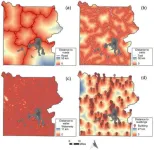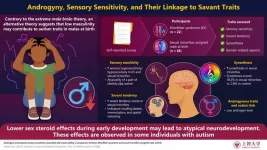(Press-News.org) People who live close to airports and are exposed to high aircraft noise levels could be at greater risk of poor heart function, increasing the likelihood of heart attacks, life-threatening heart rhythms and strokes, according to a new study led by UCL (University College London) researchers.
The study, published in the Journal of the American College of Cardiology (JACC), looked at detailed heart imaging data from 3,635 people who lived close to four major airports in England.
Within this group, the research team compared the hearts of those who lived in areas with higher aircraft noise with those who lived in lower aircraft noise areas.
They found that those who lived in areas with higher than recommended aircraft noise levels had stiffer and thicker heart muscles* that contracted and expanded less easily and were less efficient at pumping blood around the body.
This was especially the case for people exposed to higher aircraft noise at night, potentially due to factors such as impaired sleep and the fact that people are more likely to be at home at night and therefore exposed to the noise.
The researchers found in separate analyses of people not exposed to aircraft noise, that these types of heart abnormalities could result in two- to four-fold increased risks of a major cardiac event such as a heart attack, life-threatening heart rhythms, or stroke when compared to the risk of persons without any of these heart abnormalities.
Senior author Dr Gaby Captur (UCL Institute of Cardiovascular Science and consultant cardiologist at the Royal Free Hospital, London) said: “Our study is observational so we cannot say with certainty that high levels of aircraft noise caused these differences in heart structure and function.
“However, our findings add to a growing body of evidence that aircraft noise can adversely affect heart health and our health more generally.
“Concerted efforts from government and industry are needed to reduce our exposure to aircraft noise and mitigate its impact on the health of millions of people who live close to airports or under flight paths.”
Professor Anna Hansell from the University of Leicester added: “We are concerned that the type of abnormalities we saw with night-time aircraft noise might result in increased risk of heart problems and stroke. Aircraft noise at night has been shown to affect sleep quality** and this may be an important factor affecting health.
“The role of noise on heart health is currently under investigation. However, there are many established ways to look after your heart. These include eating a healthy and balanced diet, keeping physically active, maintaining a healthy weight, giving up smoking if you smoke, reducing alcohol consumption, keeping conditions such as high blood pressure and diabetes under control, and taking medication including cholesterol-lowering drugs if prescribed by your doctor.”
As well as affecting sleep, noise from our environment can trigger stress responses and lead to an over-activation of the sympathetic nervous system (the network of nerves that controls our “fight or flight” response), causing blood pressure to rise, arteries to constrict or dilate, and slower digestion. It can also cause the release of cortisol, the stress hormone, which can increase the appetite and cause weight gain.
Aircraft noise may be more annoying than road or rail noise because of louder but intermittent noisy events and the unpredictability of the sound which makes it difficult to get used to.
It is already known that exposure to high levels of aircraft noise is linked to higher blood pressure and obesity. In the new study, both factors were found to account for a significant portion of the link between aircraft noise and differences in heart structure and function.
First author Dr Cristian Topriceanu (UCL Institute of Cardiovascular Science) explained: “Between a quarter and half of the link was attributed to a higher BMI (body mass index) among participants exposed to higher levels of aircraft noise, while between 9% to 36% of the link was attributed to these participants having higher blood pressure (this was among those exposed to day-time aircraft noise only).
“Other factors that could be triggered by the stress response to aircraft noise include impaired sleep, inflammation, and atherosclerosis (build-up of fats, cholesterol and other substances in our arteries).”
For the new study, researchers looked at data from the UK Biobank of 3,635 participants who had had detailed magnetic resonance imaging (MRI) of the heart and who lived near Heathrow, Gatwick, Birmingham or Manchester airports.
They used UK Civil Aviation Authority estimates of aircraft noise level for every 100 square metres within those areas. Higher aircraft noise was defined as over 50 decibels on average during the day and 45 decibels on average during the night (11pm-7am). This is louder than the aircraft noise limits of 45 decibels on average during the day and 40 decibels on average at night recommended by the World Health Organization.
Among the UK Biobank participants in these areas, 8% lived in an area with high day-time aircraft noise, with 3% in an area with high night-time noise.
Comparing the hearts of individuals in higher and lower aircraft noise areas, the researchers took into account a wide variety of factors that might have skewed the results, including age, sex, BMI, socioeconomic status, lifestyle factors such as whether participants smoked and exercised, as well as participants’ exposure to road and rail noise and air pollution.
Heart MRIs were done at least three years after the estimates of aircraft noise in the participants’ neighbourhoods.
Participants who stayed in a higher aircraft noise area, the researchers found, had about 10-20% worse heart structure and function than their counterparts in these areas who moved away.
The research team then looked at a separate sample of 21,360 people who had detailed MRI scans of the heart as part of the UK Biobank study to investigate how heart abnormalities comparable to those linked to higher aircraft noise might affect the risk of a major adverse cardiac event.
They concluded that a hypothetical individual with these heart abnormalities may have up to four times the risk of an event such as a heart attack, abnormal heart rhythm, or stroke.
Earlier research led by the University of Leicester estimated that about 5% of adults in England were exposed to aircraft noise exceeding 50 decibels either during the day or night.***
Professor James Leiper, Associate Medical Director at the British Heart Foundation, said: “For most of us, a plane is seen as a ticket to some well-deserved rest and relaxation. But this innovative study reveals the potential invisible impact for those living close to some of our biggest travel hubs.
“While observational studies like this can’t prove cause and effect, these findings add to previous research showing the damaging impact of noise pollution on our heart health. Further research will be needed to investigate the longer-term effects of aircraft noise on the health of those with the highest exposure.”
The study received funding from the Medical Research Council, British Cardiovascular Society, British Heart Foundation, a UCL Charlotte and Yule Bogue Research Fellowship, and the National Institute for Health and Care Research (NIHR)
*Thickening of the heart is when the heart muscle cells enlarge and the walls of the heart chambers thicken. In this case, the thickening is not beneficial so rather than making the heart muscle pump more efficiently, it has the reverse effect as a maladaptively thickened heart becomes stiffer over time and less able to pump blood around the body.
** https://doi.org/10.1289/EHP14156
***https://www.sciencedirect.com/science/article/pii/S0160412023002398
END
Exposure to aircraft noise linked to worse heart function
2025-01-08
ELSE PRESS RELEASES FROM THIS DATE:
Deans of the University of Nottingham visited Korea University's College of Medicine
2025-01-08
Deans of the University of Nottingham Visited Korea University's College of Medicine
Korea University's College of Medicine Dean, Sung Bom Pyun, and Deans of the University of Nottingham; successfully held a researcher meeting program for 2 days from November 11th to 12th.
Fuve representative deans visited the University of Korea: Professor Claire Stewart, the Dean and Head of the School of Medicine at the University of Nottingham; Professor Nigel Mongan, Professor Alan McIntyre, Professor Srinivasan Madhusudan, and Professor Victoria James. They joined the program to conduct a tour and meeting with Korea University's researchers.
On ...
New study assesses wildfire risk from standing dead trees in Yellowstone National Park
2025-01-08
Standing dead trees in Yellowstone National Park are growing wildfire hazards, especially near park infrastructure. A new study published in Forest Ecosystems explores how these dead trees contribute to fire risk and threaten roads, buildings, and trails.
Dead trees, particularly those that remain standing, are a significant fire hazard. These trees—often caused by pests, diseases, and climate change—create a large amount of dry, combustible material. As temperatures rise and droughts intensify, the risk of wildfires increases, making it essential to understand how dead trees contribute to fire danger.
The team used a random forest classification model, a powerful ...
A new approach for improving hot corrosion resistance and anti-oxidation performance in silicide coating on niobium alloys
2025-01-08
The widely used nickel-based superalloys for turbine engine materials showed a limited-service temperature of only 1200℃, and did not exceed 1500℃ even when coated with thermal barrier coatings, which is urgent to develop the advanced thermal protection system for turbine engines with higher thrust-weight ratios. Niobium alloy coated with silicide coating is undoubtedly considered the most efficient method to reach long-term service, since it can form a dense SiO2 layer with self-healing ability at high temperatures. However, the single silicide coating has a strong tendency to crack vertically ...
UC San Diego to lead data hub of CDC-funded pandemic preparedness network
2025-01-08
The Centers for Disease Control and Prevention (CDC) has selected University of California San Diego as one of three partner institutions to establish a groundbreaking pandemic preparedness initiative, the Community and Household Acute Respiratory Illness Monitoring (CHARM) Network. The new five-year cooperative agreement will help generate information on how respiratory viruses spread and provide insights into factors impacting susceptibility to respiratory illnesses. At UC San Diego, the cooperative agreement supports the $5.7 million project, “PREVENT: Preparedness through Respiratory Virus Epidemiology and Community Engagement” led by Louise Laurent, M.D., Ph.D., ...
Biomimetic teakwood structured environmental barrier coating
2025-01-08
The core message of the article is that researchers have developed an innovative technology in plasma spraying-physical vapor deposition known as alternating vapor/liquid phase deposition. By adjusting the arc current, researchers can finely control the evaporation and deposition of SiO2, and through a heat treatment process, achieve in-situ reactions that optimize the composition, structure, and nanoscale dimensions of the coating, creating an orderly arranged multi-layered teak-like biomimetic structure within it. They have conducted an in-depth analysis of the complex deposition mechanisms involved in this process. This new teak-like biomimetic structure coating is expected ...
Low-cost system will improve communications among industrial machines
2025-01-08
Researchers have found a low-power, inexpensive way for large numbers of devices, such as machines in factories and equipment in labs, to share information by efficiently using signals at untapped high frequencies.
The technology could immediately enable low-cost, efficient real-time monitoring in industrial settings, such as tracking the condition of manufacturing robots or detecting gas leaks in refineries, by eliminating the need for power-hungry signal transmitters. The researchers said that with some engineering improvements, the technology ...
Elderberry juice shows benefits for weight management, metabolic health
2025-01-08
SPOKANE, Wash.—Elderberry juice may be a potent tool for weight management and enhancing metabolic health, according to a recent Washington State University-led study.
A clinical trial published in the journal Nutrients found that drinking 12 ounces of elderberry juice daily for a week causes positive changes in the gut microbiome and improves glucose tolerance and fat oxidation.
Elderberry, a small dark purple berry found on elder trees native to Europe, is commonly used as a medicinal plant and supplement to promote immune function. Its other potential health benefits are poorly understood, however.
“Elderberry ...
A new era in genetic engineering
2025-01-08
Influential inventions often combine existing tools in new ways. The iPhone, for instance, amalgamated the telephone, web browser and camera, among many other devices.
The same is now possible in gene editing. Rather than employ separate tools for editing genes and regulating their expression, these distinct goals can now be combined into a single tool that can simultaneously and independently address different genetic diseases in the same cell.
Merging Gene Editing and Regulation
In a new paper in Nature ...
Study identifies coastal black pine trees resistant to tsunamis and strong winds
2025-01-08
Researchers in Japan have found that the taller the Japanese black pine trees (Pinus thunbergii) along the coast, the deeper their roots go into the ground. Trees with deeper roots are more resistant to damage from tsunamis and strong winds. Their findings suggest that the resilience of coastal P. thunbergii trees may be improved by inducing deep root growth, specifically in short trees. The study was published in the Journal of Forest Research.
Many P. thunbergii trees have been planted in coastal forests in Japan because they are salt-tolerant and can grow in sandy soils lacking nutrients. P. thunbergii ...
From gender dysphoria to special skills: decoding the link
2025-01-08
Why have males been overrepresented among geniuses in STEM fields so far? A popular biological psychological explanation is the Extreme Male Brain Theory (EMB), which suggests that an overdose of prenatal androgen (male hormone) leads to the hyper-masculine brain type, characterized by a strong geek tendency and insensitivity to others' feelings. This theory explains the etiology of autism spectrum disorder (ASD) and inevitably connects prenatal androgen action with talents in specific fields.
However, the current research shows evidence that the opposite story might be true: reduced androgen exposure in ...







